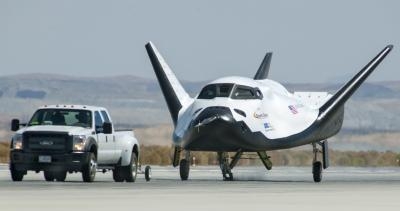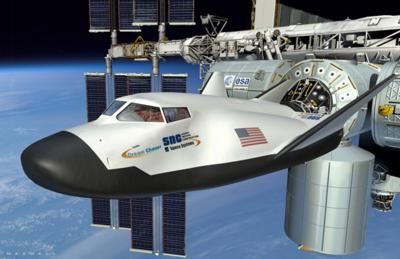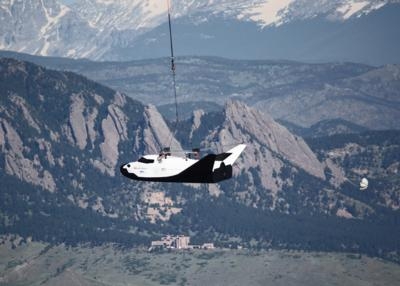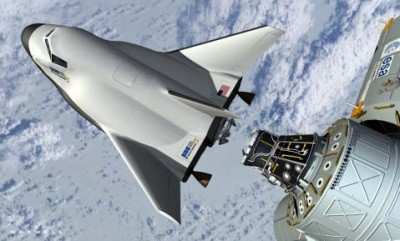Mon, Oct 28, 2013
Left Main Gear Failure Mars Otherwise Stunning Flight
Sierra Nevada Corporation’s (SNC) Dream Chaser lifting body spacecraft conducted its maiden flight at the Dryden Flight Research Center last Saturday. However, mechanical failure during landing resulted in it flipping over on the runway.

SNC’s Dream Chaser is one of three vehicles selected by NASA for their Commercial Crew Development Program. The Dream Chaser carries on a developmental history of lifting body aircraft that started in the mid 1950’s, but was abandoned during the race for the moon for the simpler space capsule and parachute combination. But now, SNC believes their spacecraft will continue the legacy of the Space Shuttle in transporting crews to the International Space Station.
After being released from an Erickson Air-Crane helicopter, the unmanned Dream Chaser’s automated flight control system steered the vehicle. The vehicle adhered to the design flight trajectory throughout the flight profile. Less than a minute after release, Dream Chaser touched down at Edwards Air Force Base.
While the failure of the left landing gear after touchdown led to the accident, SNC reported that the high-quality flight and telemetry data throughout all phases of the approach-and-landing test will allow SNC teams to continue to refine their spacecraft design.

SNC issued a statement noting, "The vehicle successfully released from its carrier aircraft, an Erickson Air-Crane helicopter, as planned at approximately 11:10 a.m. Pacific Standard Time. Following release, the Dream Chaser spacecraft automated flight control system gently steered the vehicle to its intended glide slope. The vehicle adhered to the design flight trajectory throughout the flight profile. Less than a minute later, Dream Chaser smoothly flared and touched down on Edwards Air Force Base’s Runway 22L right on centerline. While there was an anomaly with the left landing gear deployment, the high-quality flight and telemetry data throughout all phases of the approach-and-landing test will allow SNC teams to continue to refine their spacecraft design. SNC and NASA Dryden are currently reviewing the data. As with any space flight test program, there will be anomalies that we can learn from, allowing us to improve our vehicle and accelerate our rate of progress."
Adapted from an F-5 landing gear, the system was already scheduled to be replaced on future vehicles.



More News
With Testing Soon Complete, Launch Preparations Begin in Earnest Sierra Space's Dream Chaser has been put through the wringer at NASA's Glenn Armstrong Test Facility in Ohio, but w>[...]
Takeoff Roll The process whereby an aircraft is aligned with the runway centerline and the aircraft is moving with the intent to take off. For helicopters, this pertains to the act>[...]
“We’re proud of the hard work that went into receiving this validation, and it will be a welcome relief to our customers in the European Union. We couldn’t be mor>[...]
"Aircraft Spruce is pleased to announce the acquisition of the parts distribution operations of Wag-Aero. Wag-Aero was founded in the 1960’s by Dick and Bobbie Wagner in the >[...]
IDENT Feature The special feature in the Air Traffic Control Radar Beacon System (ATCRBS) equipment. It is used to immediately distinguish one displayed beacon target from other be>[...]
 Sierra Space Repositions Dream Chaser for First Mission
Sierra Space Repositions Dream Chaser for First Mission ANN's Daily Aero-Term (05.10.24): Takeoff Roll
ANN's Daily Aero-Term (05.10.24): Takeoff Roll Aero-News: Quote of the Day (05.10.24)
Aero-News: Quote of the Day (05.10.24) Aero-News: Quote of the Day (05.11.24)
Aero-News: Quote of the Day (05.11.24) ANN's Daily Aero-Term (05.11.24): IDENT Feature
ANN's Daily Aero-Term (05.11.24): IDENT Feature






